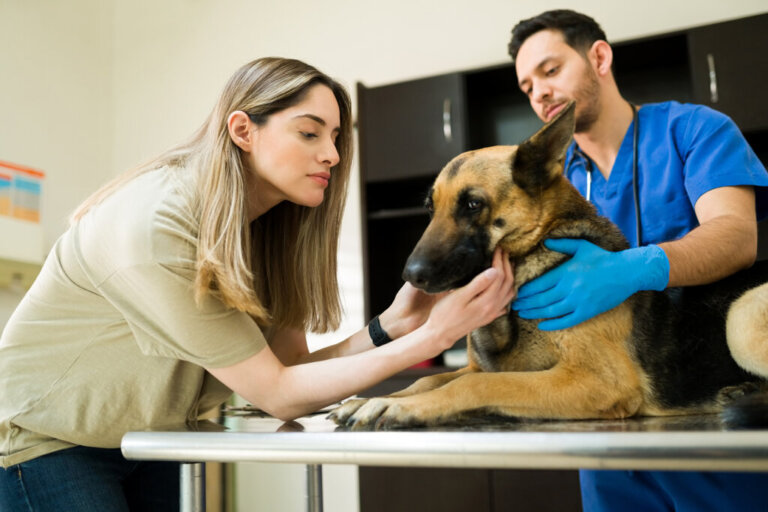Euthanasia in Dogs: What You Should Know


Written and verified by the veterinarian and zootechnician Sebastian Ramirez Ocampo
Saying goodbye isn’t easy, especially when it comes to a loyal and loving being that has accompanied you during many stages of your life. However, certain conditions lead to such a deterioration of the quality of life that euthanasia in dogs is presented as a viable alternative to avoid the prolongation of pain and suffering.
It’s normal for many concerns and feelings to arise around this practice. For this reason, being aware of the ethical, legal, and emotional aspects will allow you to make the right decision in difficult moments. Keep reading the following article and find out everything you need to know about this procedure.
First step: Understanding euthanasia in dogs
In the specific case of Spain, and following the 2020 guide to euthanasia, the American Veterinary Medical Association (AVMA) defines this procedure as “ending the life of an individual animal in a way that minimizes or eliminates pain and distress.”
According to this definition, euthanasia could be considered a compassionate technique that seeks to alleviate a pet’s suffering by providing a gentle and peaceful death.
However, the practice of euthanasia in dogs shouldn’t be taken lightly. It should be considered only in cases where the dog’s quality of life is severely compromised and medical treatment is insufficient or the disease has no cure.
As stated by the authors of the guide, this procedure must meet two conditions to be qualified as valid:
- It must be performed by a professional and only for the purposes of animal health and welfare.
- Humane techniques must be used to induce a quick, painless, and distress-free death.
Therefore, if assisted death isn’t carried out under these parameters, it can’t be considered euthanasia, but rather, sacrifice.
The differences between euthanasia and sacrifice
Unlike euthanasia, sacrifice doesn’t take into consideration the animal’s state of health. Rather, death is performed for reasons unrelated to the animal’s welfare. For example, as stated in an article in the journal The Veterinary Record, in the United States and the United Kingdom, dogs are put down every year in shelter centers due to overpopulation and the lack of people to adopt them.
However, it should be noted that in countries such as Spain, the Law for the Protection of Animal Rights and Welfare explicitly prohibits the slaughter of animals in protection centers and veterinary clinics for the following reasons:
- Overpopulation
- Economic issues
- Lack of room in shelters
- The impossibility of finding an adopter
- Guardian abandonment
- Old age
- Illnesses that are treatable
- Behavioral problems

What does the law say about euthanasia in dogs?
According to what’s stipulated in the Law for the Protection of Animal Rights and Welfare, euthanasia “is only justified under veterinary criteria and control, with the sole purpose of avoiding suffering due to non-recoverable causes that compromise the animal’s quality of life.”
In addition, a professional must accredit and perform this procedure, with methods that guarantee the humane condition and correspond to those authorized by the legal provisions.
For this reason, it’s not acceptable for an owner or private person to sacrifice dogs, especially for reasons that aren’t related to health. Otherwise, the subject will be implicated in a crime and will incur a very serious infraction.
How do you know it’s time to euthanize your dog?
Although it may be difficult, there are certain behaviors that help to identify when it’s time to make this complex decision. In this regard, you can look at the following manifestations, which may be present in your dog:
- The inability to experience the things it once enjoyed
- A response that’s different than usual
- More expressions of pain than pleasure.
In these cases, you need to ask yourself the question, “Does my dog have more bad days than good days?”. The answer to this question will serve as a basis for considering resorting to this alternative. While it’s normal to want their company throughout life, clinging to their presence can be detrimental because it means prolonging the suffering for both the pet and its guardian.
Therefore, it’s possible to qualify euthanasia as an accepted moral and ethical option because its purpose is compassionate and humanitarian.
In which diseases is euthanasia in dogs justified?
As has been well explained, euthanasia in dogs should only be considered as a last option in cases where the welfare of an animal is severely compromised. Specifically, as stated in two articles in Scientific Reports and the journal Animals, among the diseases in which euthanasia in dogs is most recommended, we can find the following:
- Cancer: Especially if it has spread to different organs. Also, when the prognosis with chemotherapy is unfavorable.
- Cardiovascular diseases: When there’s no response to treatment and the deterioration of health is incompatible with a good quality of life.
- Multi-organ failure: In cases where the disease compromises several vital systems for the animal. For example, chronic end-stage renal failure.
- Spinal cord disorders: These include congenital defects, degenerative diseases, and severe traumas that affect the proper mobility of the animal.

How is euthanasia performed in dogs?
As outlined in a publication by the World Society for the Protection of Animals (WSPA), the most effective method for a quick, painless, and irreversible death is the injection of drugs intravenously. The objective is to cause cardiorespiratory arrest in the affected animal.
According to this document, the drug of choice is 20% pentobarbital, which is fast-acting and has no worrying side effects. Similarly, prior sedation of the patient with drugs such as acepromazine, xylazine, or ketamine is recommended.
As reported in a study by the Journal of Veterinary Emergency and Critical Care, anesthetics such as propofol work well to help the dog reach a calm state prior to lethal injection.
To confirm the death of the canine, the following signs should be observed and confirmed:
- Lack of respiratory movements
- The absence of heartbeat by auscultation
- No pulse is felt
- Loss of the blink reflex
- Glassy eyes
- Muscular rigidity
What is the cost?
There are several factors that determine the value of euthanasia. Its cost is estimated between 200 to 400 euros, which is determined by the following services:
- Veterinary consultation: between 20 and 30 euros.
- Medications: according to the protocol used, their value will be between 50 to 70 euros.
- Cremation of the body: it depends on the weight and whether the cremation is individual or collective, the price can be 150 to 300 euros, respectively.
This, as mentioned before, will depend a lot on where you live. The previous reference is an approximation to the case of Spain.
Euthanasia in dogs: A decision based on love
If your pet suffers from a terminal illness with an unfavorable prognosis, giving them a break from their suffering is the ultimate act of kindness you could do for him. However, remember to consult with a veterinarian about whether your dog’s condition can be improved with medical treatment or if there are other options.
Similarly, emotional preparation and discussing the decision with all family members can make this difficult situation more bearable. Also, make sure that their last moments of life are ones of pure enjoyment by giving them whatever they want to eat. Finally, it’s important that they feel that they’re not alone, as this will also make it easier for your pet.
Saying goodbye isn’t easy, especially when it comes to a loyal and loving being that has accompanied you during many stages of your life. However, certain conditions lead to such a deterioration of the quality of life that euthanasia in dogs is presented as a viable alternative to avoid the prolongation of pain and suffering.
It’s normal for many concerns and feelings to arise around this practice. For this reason, being aware of the ethical, legal, and emotional aspects will allow you to make the right decision in difficult moments. Keep reading the following article and find out everything you need to know about this procedure.
First step: Understanding euthanasia in dogs
In the specific case of Spain, and following the 2020 guide to euthanasia, the American Veterinary Medical Association (AVMA) defines this procedure as “ending the life of an individual animal in a way that minimizes or eliminates pain and distress.”
According to this definition, euthanasia could be considered a compassionate technique that seeks to alleviate a pet’s suffering by providing a gentle and peaceful death.
However, the practice of euthanasia in dogs shouldn’t be taken lightly. It should be considered only in cases where the dog’s quality of life is severely compromised and medical treatment is insufficient or the disease has no cure.
As stated by the authors of the guide, this procedure must meet two conditions to be qualified as valid:
- It must be performed by a professional and only for the purposes of animal health and welfare.
- Humane techniques must be used to induce a quick, painless, and distress-free death.
Therefore, if assisted death isn’t carried out under these parameters, it can’t be considered euthanasia, but rather, sacrifice.
The differences between euthanasia and sacrifice
Unlike euthanasia, sacrifice doesn’t take into consideration the animal’s state of health. Rather, death is performed for reasons unrelated to the animal’s welfare. For example, as stated in an article in the journal The Veterinary Record, in the United States and the United Kingdom, dogs are put down every year in shelter centers due to overpopulation and the lack of people to adopt them.
However, it should be noted that in countries such as Spain, the Law for the Protection of Animal Rights and Welfare explicitly prohibits the slaughter of animals in protection centers and veterinary clinics for the following reasons:
- Overpopulation
- Economic issues
- Lack of room in shelters
- The impossibility of finding an adopter
- Guardian abandonment
- Old age
- Illnesses that are treatable
- Behavioral problems

What does the law say about euthanasia in dogs?
According to what’s stipulated in the Law for the Protection of Animal Rights and Welfare, euthanasia “is only justified under veterinary criteria and control, with the sole purpose of avoiding suffering due to non-recoverable causes that compromise the animal’s quality of life.”
In addition, a professional must accredit and perform this procedure, with methods that guarantee the humane condition and correspond to those authorized by the legal provisions.
For this reason, it’s not acceptable for an owner or private person to sacrifice dogs, especially for reasons that aren’t related to health. Otherwise, the subject will be implicated in a crime and will incur a very serious infraction.
How do you know it’s time to euthanize your dog?
Although it may be difficult, there are certain behaviors that help to identify when it’s time to make this complex decision. In this regard, you can look at the following manifestations, which may be present in your dog:
- The inability to experience the things it once enjoyed
- A response that’s different than usual
- More expressions of pain than pleasure.
In these cases, you need to ask yourself the question, “Does my dog have more bad days than good days?”. The answer to this question will serve as a basis for considering resorting to this alternative. While it’s normal to want their company throughout life, clinging to their presence can be detrimental because it means prolonging the suffering for both the pet and its guardian.
Therefore, it’s possible to qualify euthanasia as an accepted moral and ethical option because its purpose is compassionate and humanitarian.
In which diseases is euthanasia in dogs justified?
As has been well explained, euthanasia in dogs should only be considered as a last option in cases where the welfare of an animal is severely compromised. Specifically, as stated in two articles in Scientific Reports and the journal Animals, among the diseases in which euthanasia in dogs is most recommended, we can find the following:
- Cancer: Especially if it has spread to different organs. Also, when the prognosis with chemotherapy is unfavorable.
- Cardiovascular diseases: When there’s no response to treatment and the deterioration of health is incompatible with a good quality of life.
- Multi-organ failure: In cases where the disease compromises several vital systems for the animal. For example, chronic end-stage renal failure.
- Spinal cord disorders: These include congenital defects, degenerative diseases, and severe traumas that affect the proper mobility of the animal.

How is euthanasia performed in dogs?
As outlined in a publication by the World Society for the Protection of Animals (WSPA), the most effective method for a quick, painless, and irreversible death is the injection of drugs intravenously. The objective is to cause cardiorespiratory arrest in the affected animal.
According to this document, the drug of choice is 20% pentobarbital, which is fast-acting and has no worrying side effects. Similarly, prior sedation of the patient with drugs such as acepromazine, xylazine, or ketamine is recommended.
As reported in a study by the Journal of Veterinary Emergency and Critical Care, anesthetics such as propofol work well to help the dog reach a calm state prior to lethal injection.
To confirm the death of the canine, the following signs should be observed and confirmed:
- Lack of respiratory movements
- The absence of heartbeat by auscultation
- No pulse is felt
- Loss of the blink reflex
- Glassy eyes
- Muscular rigidity
What is the cost?
There are several factors that determine the value of euthanasia. Its cost is estimated between 200 to 400 euros, which is determined by the following services:
- Veterinary consultation: between 20 and 30 euros.
- Medications: according to the protocol used, their value will be between 50 to 70 euros.
- Cremation of the body: it depends on the weight and whether the cremation is individual or collective, the price can be 150 to 300 euros, respectively.
This, as mentioned before, will depend a lot on where you live. The previous reference is an approximation to the case of Spain.
Euthanasia in dogs: A decision based on love
If your pet suffers from a terminal illness with an unfavorable prognosis, giving them a break from their suffering is the ultimate act of kindness you could do for him. However, remember to consult with a veterinarian about whether your dog’s condition can be improved with medical treatment or if there are other options.
Similarly, emotional preparation and discussing the decision with all family members can make this difficult situation more bearable. Also, make sure that their last moments of life are ones of pure enjoyment by giving them whatever they want to eat. Finally, it’s important that they feel that they’re not alone, as this will also make it easier for your pet.
All cited sources were thoroughly reviewed by our team to ensure their quality, reliability, currency, and validity. The bibliography of this article was considered reliable and of academic or scientific accuracy.
- American Veterinary Medical Association. (15 de enero de 2020). AVMA Guidelines for the Euthanasia of Animals: 2020 Edition. https://olaw.nih.gov/policies-laws/avma-guidelines-2020.htm
- Bullock, J. M., Lanaux, T. M., & Shmalberg, J. W. (2019). Comparison of pentobarbital-phenytoin alone vs propofol prior to pentobarbital-phenytoin for euthanasia in 436 client-owned dogs. Journal of Veterinary Emergency and Critical Care (San Antonio, Tex: 2001), 29(2), 161–165. https://onlinelibrary.wiley.com/doi/10.1111/vec.12813
- Gobierno de España. (2023). Ley 7/2023, de 28 de marzo, de protección de los derechos y el bienestar de los animales. BOE núm. 75. https://www.boe.es/buscar/doc.php?id=BOE-A-2023-7936
- Lund, H. S., Eggertsson, S., Grøndahl, A. M., & Eggertsdóttir, A. V. (2010). Views on euthanasia and the rehoming of dogs in Norway and Iceland. The Veterinary record, 166(24), 749–752. https://bvajournals.onlinelibrary.wiley.com/doi/abs/10.1136/vr.b4856
- Mota-Rojas, D., Domínguez-Oliva, A., Martínez-Burnes, J., Casas-Alvarado, A., & Hernández-Ávalos, I. (2023). Euthanasia and Pain in Canine Patients with Terminal and Chronic-Degenerative Diseases: Ethical and Legal Aspects. Animals: an Open Access Journal from MDPI, 13(7), 1265. https://www.ncbi.nlm.nih.gov/pmc/articles/PMC10093422/
- Pegram, C., Gray, C., Packer, R. M. A., Richards, Y., Church, D. B., Brodbelt, D. C., & O’Neill, D. G. (2021). Proportion and risk factors for death by euthanasia in dogs in the UK. Scientific Reports, 11(1), 9145. https://www.ncbi.nlm.nih.gov/pmc/articles/PMC8096845/
- Tasker, L. (2018). Methods for the euthanasia of dogs and cats: comparison and recommendations. Companion Animals Unit, World Society for the Protection of Animals. https://www.icam-coalition.org/download/methods-for-the-euthanasia-of-dogs-and-cats/
This text is provided for informational purposes only and does not replace consultation with a professional. If in doubt, consult your specialist.








